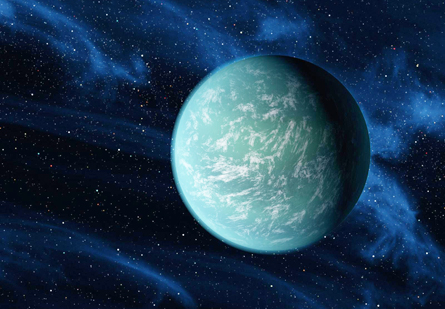MOUNTAIN VIEW, Calif. — One of the many worlds circling faraway suns is tracing a most Earthlike path: The planet Kepler-22b has a 290-day orbit that parks it firmly within its star’s life-friendly zone, scientists announced December 5 at the first Kepler Science Conference.

With a radius 2.4 times larger than Earth’s, Kepler-22b is the smallest planet confirmed to sit comfortably in a sunlike star’s “habitable zone,” or the zone around a star where temperatures allow liquid water to exist. Kepler-22b’s home star — shining 600 light-years away near the constellation Cygnus — is very similar to the sun, though a bit cooler.
“Today’s discovery is a tantalizing indication that with time, Kepler might find true Earth analogs, if they exist,” said Pete Worden, the director of NASA’s Ames Research Center in Mountain View, Calif. The Kepler team’s goal is to detect Earth-sized exoplanets within the habitable zones of their parent stars, a task that requires years of observing time.
The space telescope stares at a patch of sky near the constellation Cygnus that sparkles with more than 150,000 stars. A planet passing in front of one of these stars produces a telltale dimming in the star’s light, and scientists use these flickers to calculate a planet’s radius and orbital period. The team waits for three of these dimming events before considering whether a planet might be the culprit, which is why detecting longer, Earthlike orbits takes years.
The telescope spotted Kepler-22b’s first transit just after observations began in 2009, and the third transit occurred just before Christmas 2010. “It’s a great gift,” said Kepler principal investigator Bill Borucki of NASA’s Ames Research Center. “We consider this sort of our Christmas planet.” Scientists don’t yet know whether the planet is rocky or gassy, but hope that further observations will point toward the answer.
If Kepler-22b does have a surface — and an atmosphere — its average surface temperature should hover around 72 degrees Fahrenheit. “It would be like a pleasant day on Earth, a little bit warmer than we have today in California,” Borucki said.
So far, the telescope’s 1,000-day stare has allowed it to glimpse thousands of potential planets, including 1,094 new candidates announced at the conference. These newbies bring the total number of exotreasures in the Kepler clutch to 2,326, including 207 Earth-sized — and smaller — planets. “Not only do we have Earth-size planets, we have planets that are significantly smaller than Earth,” said Kepler scientist Natalie Batalha of San Jose State University in California.
Providing tantalizing targets for those in search of intelligent life are another 10 potential Earth-sized candidates in their stars’ habitable zones. Five are “very, very viable candidates,” Batalha said, noting that about 20 percent of the candidate planets are organized in planetary systems, which make it easier to confirm the presence of the littlest, most Earthlike orbs.
Astronomer Jill Tarter of the SETI Institute in Mountain View, Calif., said she and her team will be using the Allen Telescope Array — back online just this morning after a hiatus caused by funding problems — to eavesdrop on the entire Kepler field and listen for radio signals of intelligent origin. “We’re once again looking at all the Kepler exoplanets,” she said. But, she added, “We will give a higher priority to those worlds that our colleagues tell us are not too warm, and not too cold, but just right.”







